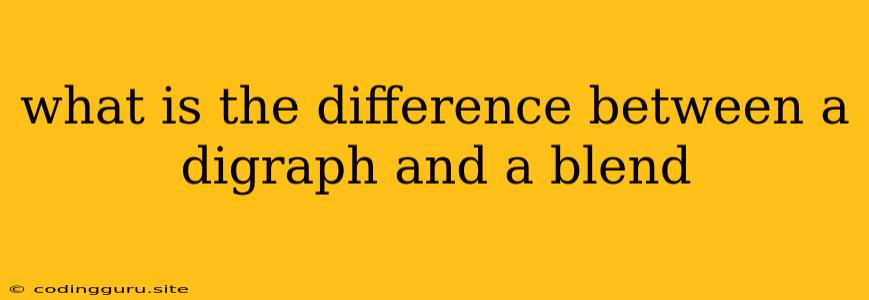What's the Difference Between a Digraph and a Blend?
When exploring the world of phonics, you'll encounter terms like "digraph" and "blend." While these terms sound similar, they represent distinct phonetic concepts. Understanding the difference is key to unlocking the secrets of English spelling and pronunciation.
Digraphs are two letters that represent one sound. These pairs work together as a team, not individually. Think of them like a secret code!
Blends, on the other hand, are two or three consonants that are blended together, with each sound being heard. Imagine them as partners, each contributing their own voice to a unique sound.
Let's dive into the details:
What is a Digraph?
A digraph is a combination of two letters that represent a single sound. While the letters themselves may have their own individual sounds, when they appear together, they create a unique and distinct sound.
Examples of Digraphs:
- sh in "ship"
- ch in "chair"
- th in "thin"
- ph in "phone"
- wh in "what"
- ck in "sock"
- ng in "sing"
- ai in "rain"
- ea in "meat"
- oo in "moon"
What is a Blend?
A blend is a group of two or three consonants that are blended together, but each individual sound can be heard. These consonants work together to form a larger sound, but their individual sounds are still recognizable.
Examples of Blends:
- bl in "blue"
- cl in "cloud"
- fl in "flower"
- gl in "glass"
- pl in "play"
- sl in "sleep"
- br in "brown"
- cr in "crab"
- dr in "drum"
- fr in "frog"
- gr in "green"
- pr in "pretty"
- sc in "school"
- sk in "sky"
- sn in "snake"
- sp in "spoon"
- st in "star"
- sw in "swim"
- tr in "tree"
- tw in "twin"
Identifying Digraphs and Blends: A Simple Trick
To distinguish between digraphs and blends, try saying the word aloud and focusing on the individual sounds you hear.
- If you hear only one sound for the two letters, you're dealing with a digraph.
- If you hear two or three distinct sounds, you're dealing with a blend.
Digraphs vs. Blends: A Table for Easy Understanding
| Feature | Digraph | Blend |
|---|---|---|
| Number of letters | Two | Two or three |
| Number of sounds | One | Two or three |
| Sounds produced | Unique, different from individual letter sounds | Individual letter sounds blended together |
| Examples | sh in "ship", ch in "chair" | bl in "blue", cr in "crab" |
The Importance of Knowing the Difference
Understanding the difference between digraphs and blends is crucial for both reading and spelling. It helps us:
- Decode words correctly: Knowing that "sh" represents one sound helps us sound out words like "ship," "shell," and "shop."
- Spell words accurately: Recognizing a blend like "st" in "star" helps us write the word correctly.
- Improve reading fluency: Identifying digraphs and blends quickly allows us to read words more smoothly and efficiently.
Conclusion
Digraphs and blends are fundamental elements of the English language. Knowing the difference between them is essential for mastering reading and spelling skills. By understanding the unique properties of each, we can navigate the intricacies of the English language with greater confidence and ease.
